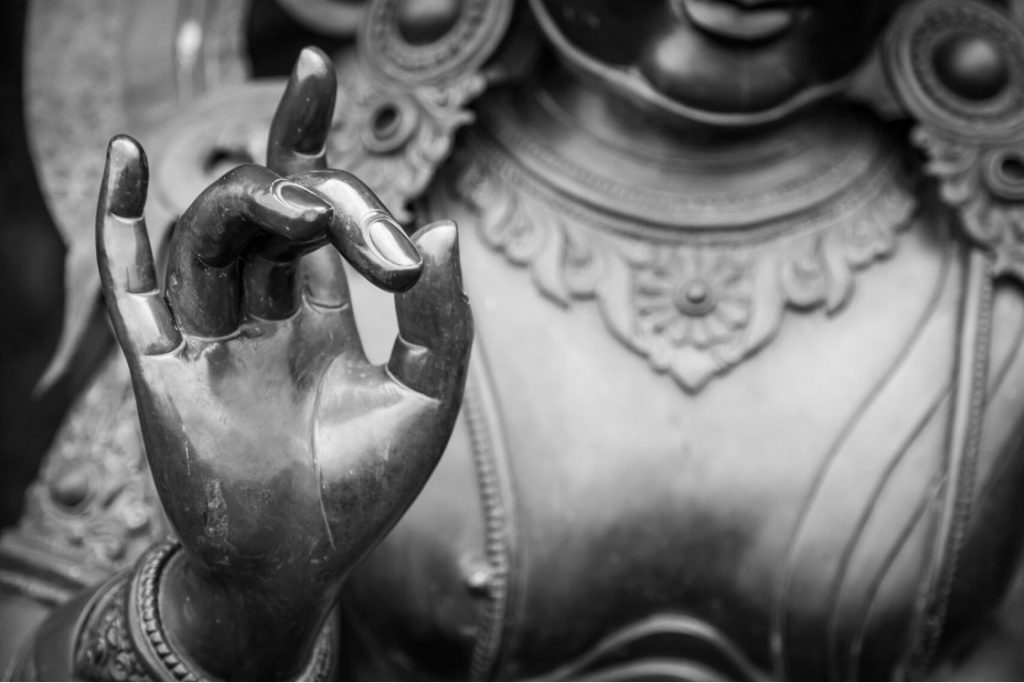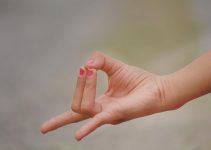
Karana Mudra, also known as the “Gesture of Banishing,” is a powerful hand gesture in yoga and meditation. It is used to dispel negative energies and create a deep sense of inner peace. Rooted in Hindu and Buddhist traditions, this mudra is famous for warding off negativity and boosting spiritual energy.
The gesture involves extending the index and little fingers upward while folding the middle and ring fingers under the thumb. This symbolizes the removal of negative influences and offers protection against harmful forces. Practicing Karana Mudra helps improve mental clarity and emotional stability and enhances spiritual connection. Try this simple yet effective mudra to overcome fear, anxiety, and negativity, and bring more balance and harmony to your life.
The philosophy behind karana Mudra
Karana Mudra, commonly seen in Buddhist traditions, is a hand gesture often depicted with Gautama Buddha during meditation. This mudra symbolizes the warding off of evil and the dispelling of negative energies, serving as a powerful tool for spiritual and emotional cleansing. According to cultural and religious beliefs, Karana Mudra helps remove mental blocks and is known as the “Gesture of Banishing” for its ability to eliminate negative emotions, sickness, and harmful forces.
The simplicity of Karana Mudra makes it accessible for practitioners during meditation or pranayama (breathing exercises), guiding them toward a state of optimism and enlightenment. To enhance its effects, this gesture can be combined with mantra chanting, such as the Ganesh mantra, to boost spiritual energy and protection.
For a variation, place your hand on your chest while performing Karana Mudra, channeling the flow of life force (prana) within your body. Use the following mantra during breathwork:
- Inhale: “May obstacles be removed.”
- Exhale: “May negative energy be thwarted.”
Karana Mudra involves pressing the middle finger against the thumb, stimulating the fire and ether elements in the body. This fosters a sense of balance and purification.
How to do karana mudra(steps)
- Sit comfortably in a meditative posture, such as Padmasana (Lotus Pose), Sukhasana (Easy Pose), Vajrasana (Thunderbolt Pose), or on a chair if preferred.
- Bring your right hand to chest level with the palm facing forward.
- Bend the middle and ring fingers toward the center of your palm.
- Press the thumb against the bent middle and ring fingers to hold them in place.
- Extend the index and little fingers straight up.
- Place your left hand on your left knee, palm facing up.
- Close your eyes and take deep, mindful breaths, focusing on your intention to dispel negativity and cultivate inner peace.
- Hold the mudra for at least 15 minutes, gradually increasing the duration as you become more comfortable.
Time Duration
- Ideal Timing: Practice Karana Mudra in the morning or evening for optimal results.
- Duration: Start with 10-15 minutes per session.
Variation
- Position your right hand in front of your chest with the palm facing outward.
- Fold the thumb, middle, and little fingers.
- Keep the index and ring fingers straight and extended.
Precautions & Contraindication
- Avoid practicing if you have recent injuries or pain in your hands or wrists, as this mudra involves specific hand movements.
- Ensure your hand is positioned correctly to avoid unnecessary tension. Misalignment can cause strain.
- If you have conditions affecting your joints or muscles, such as arthritis, consult a healthcare provider before practicing.
- Combine the mudra with mindful breathing. Improper breathing techniques can lead to dizziness or discomfort.
- Practice gradually and consistently. Overexertion or irregular practice may lead to physical or mental strain.
Karana Mudra Benefits
Karana Mudra is a simple practice that helps remove mental blocks, reduce anxiety, and create a sense of deep inner peace. By practicing this mudra regularly, it can help you grow spiritually, balance your emotions, and develop a positive attitude, making it important for overall well-being.
- Fills the Mind with Positivity: Karana Mudra helps dispel negative thoughts and fosters a positive mental environment. By focusing on the mudra, practitioners can shift their mindset toward optimism and enhance emotional resilience.
- Strengthens Inner Energy: The mudra channels and amplifies internal energy, making it easier to cultivate vitality and inner strength. This increased energy flow helps stabilize and rejuvenate both the mind and body.
- Removes Health Ailments: Practicing Karana Mudra may aid in relieving physical ailments by promoting the body’s natural healing processes. The gesture stimulates energy pathways, contributing to overall wellness and recovery.
- Instills a Sense of Security: The mudra enhances feelings of safety and stability by focusing on banishing negative energies. This sense of security supports mental clarity and emotional balance.
- Clears Mental Obstacles: Karana Mudra is effective in removing mental blocks and obstacles that hinder personal growth. By addressing and clearing these barriers, practitioners can achieve greater mental focus and peace.
- Improves Prana Flow: The specific hand position of Karana Mudra stimulates the fire and ether elements in the body, enhancing the flow of prana (life force). This improved prana flow supports overall energy levels and mental clarity.
Also Read: Varada Mudra (Boon Dispenser Gesture)
Conclusion
Defeat negative forces, ailments, and fears with Karana Mudra, a cleansing gesture that revitalizes the mind and paves the way to enlightenment. Rooted in ancient traditions, this mudra not only dispels negativity but also enhances inner energy and fosters a sense of peace and fearlessness. According to Feng Shui principles, practicing Karana Mudra can cultivate an environment of harmony and balance, both within and around us, making it an invaluable tool for spiritual and emotional growth.





i am happy, that I have found in internet your explanations about the mudras, which I find very helpful.
but my question is: what is your recommendation how to use the mudras?
just one for some days, or can you do several mudras, one after the other at one time?
thank you in advance for your answer.